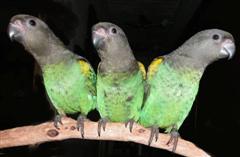Meyer's Parrot
Meyer Parrot, Brown Parrot, Meyers Parrot Scientific Name: Poicephalus meyeri meyeri
Sun, 13th July, 2025 - 7:11 am GMT
Sponsor Ads:

Alternative Name
Meyer Parrot, Brown Parrot, Meyers Parrot Scientific Name: Poicephalus meyeri meyeriBasic Info
The Meyer's Parrot is among at least six different subspecies of Poicephalus meyeri. The distinction between subspecies has been difficult for researchers, though the Meyer's Parrot is the nominate sub-species and may be most easily identified by its blue-green belly and yellow head. They also have grey plummage on their backs and yellow shoulders and crown. Mature individuals have red eyes. Like all of the subspecies the Meyer's Parrot has largely gray to brown plumage with yellow on its thighs and wings. They have dark gray bills. Males and females may be distinguished by examining their heads and beaks. The male's head is said to be larger and flatter than the females. The beak of the male is also reported to be larger than the female's beak. Visual identification is by no means reliable with the Meyer's Parrot and the only way to be 100% sure is through DNA or surgical testing. The average mature Meyer's Parrot will measure eight inches (21 cm) and weigh between three and a half and four and a half ounces (100 - 135 grams). The wingspan of the mature Meyer's Parrot will usually measure between five and a half and six inches (14.1 - 14.9 cm) in length. They are smaller in size than a Cockatiel.
Health
The Meyer's Parrot should be housed in a cage that gives it plenty of room to move. Some people keep them in large aviaries that allow flight. The average enclosure should be 40 inches long x 20 inches deep x 32 inches high. They should have plenty of perches and toys, though they also need room to move and fly. These birds seem to have a special fondness for bathing, so make sure to provide a bath. Breeding Breeding the Meyer's Parrot in captivity is more difficult than with some other species. When Breeding the Meyer's Parrot in captivity be sure to check which subspecies you have. Often other subspecies are bred with the Meyer's creating hybrids that are not pure Meyer's. Established pairs of Meyer's Parrots are known to breed readily during the winter breeding season. The average Meyer's Parrot will reach sexual maturity some time between three and four years of age. If successful breeding has occurred, three to four eggs will be laid. These eggs will need an incubation period of 26 to 27 days. Hatchlings will remain with the mother until they are 12 to 13 weeks old, though they are capable of leaving the nest at nine weeks.Habitat
They seem to prefer Savannahs and wooded regions.Behavior
The Meyer's Parrot, also known as the "Brown Parrot" or "Meyer Parrot," is quite popular in aviculture and is luckily more moderately priced than some of the larger parrots. If you are a fancier of parrots but are intimidated by the large size and cost of some of the larger breeds, the Meyer's Parrot might be the perfect breed for you. In their natural environment they live in small groups or pairs. Larger groups have been seen, but usually only in areas where food is plentiful. They are generally shy in their natural environment, and for this reason they are fairly difficult to observe. The Meyer's parrot is reported to have a softer voice than many of the larger parrots, though they are still moderately noisy birds overall. In captivity they are reported to talk in some instances. There are never any guarantees your Meyer's will speak, however, as is the case with all parrots, it is never recommended one be purchased with the expectation that it will speak. The Meyer's Parrot is known to be more active when it does not think it is being watched. Like most parrots they love to chew, and wood is a favorite. The Meyer's Parrot is quite popular among breeders and is second only to the widely kept Senegal Parrot. Its popularity will come as no surprise to those already familiar with the wonderful Meyer's Parrot.Origin
AfricaHistory
The Meyer's Parrot is native to Africa and is most common in the eastern and central regions. They seem to prefer Savannahs and wooded regions.Common Foods
In the wild the Meyer's parrot has been observed to eat nuts, berries, fruits, and seeds, though they are also known to eat cultivated grain when available.Sponsor Ads:
Confidence is the feeling you had before you knew better. -- Unknown
Meyer's Parrot
Coded by: BGID® | ALL RIGHTS RESERVED Copyright © 2000-2025
Disclaimer | Privacy | Report Errors / Contact | Credits
















